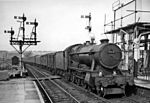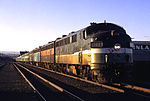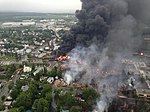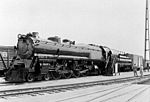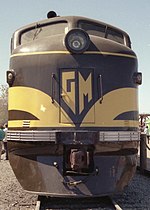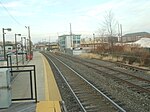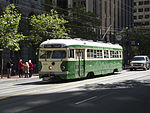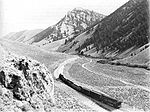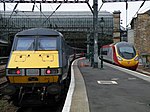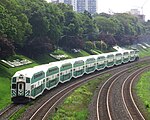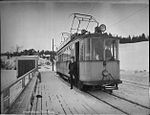Portal:Trains/Selected article/2014 archive
This is an archive of article summaries that have appeared in the Selected article section of Portal:Trains in 2012. For past archives, see the complete archive page.
- Week 1, 2014
- December 29, 2013 - January 4, 2014
Holborn is a London Underground station in Holborn central London. It is served by the Central and Piccadilly lines. On the Central line the station is between Tottenham Court Road and Chancery Lane stations; on the Piccadilly line it is between Covent Garden and Russell Square and is in Travelcard Zone 1. The station is located at the junction of High Holborn and Kingsway. Close by are the British Museum, Lincoln's Inn Fields, Red Lion Square, Bloomsbury Square and Sir John Soane's Museum. Located at the junction of two earlier tube railway schemes, the station was opened in 1906 by the Great Northern, Piccadilly and Brompton Railway (GNP&BR). The station entrances and below ground circulation were largely reconstructed for the introduction of escalators and the opening of Central line platforms in 1933, making the station the only interchange between the lines. Before 1994, Holborn was the northern terminus of the short and little-frequented Piccadilly line branch to Aldwych and two platforms originally used for this service are disused. One of the disused platforms has been used for location filming when a London Underground station platform is needed.
Recently selected: Indian Pacific - Albula Railway - Alaska Railroad
- Week 2
- January 5 - January 11
Stapleton Road railway station is on the Severn Beach Line and Cross Country Route, serving the inner-city district of Easton in Bristol, England. It is 1.6 miles (2.6 km) from Bristol Temple Meads, and was opened in 1863 by the Bristol and South Wales Union Railway. Its three letter station code is SRD. As of 2013,[update] the station has two platforms, two running lines and minimal facilities. It is currently managed by First Great Western, the seventh company to be responsible for the station, and the third franchise since privatisation in 1997. They provide all train services at the station, the standard service being a train every 40 minutes along the Severn Beach Line, an hourly service to Bristol Parkway and another hourly service to Westbury. The line is due to be electrified as part of the 21st-century modernisation of the Great Western Main Line, which will also see the addition of two new running lines to increase capacity. Service frequency will be improved as part of the Greater Bristol Metro scheme.
Recently selected: Holborn tube station - Indian Pacific - Albula Railway
- Week 3
- January 12 - January 18
The Great North of Scotland Railway (GNSR/GNoSR) was one of the smaller Scottish railways before the grouping, operating in the far north-east of the country. Formed in 1845, it carried its first passengers the 39 miles (63 km) from Kittybrewster, in Aberdeen, to Huntly on 20 September 1854. By 1867 it owned 226+1⁄4 route miles (364.1 km) of line and operated over a further 61 miles (98 km). The early expansion was followed by a period of forced economy, but in the 1880s the railway was refurbished, express services began to run and by the end of that decade there was a suburban service in Aberdeen. The railway operated its main line between Aberdeen and Keith and two routes west to Elgin, connections could be made at both Keith and Elgin for Highland Railway services to Inverness. There were other junctions with the Highland Railway at Boat of Garten and Portessie, and at Aberdeen connections for journeys south over the Caledonian and North British Railways. Its eventual area encompassed the three Scottish counties of Aberdeenshire, Banffshire and Moray, with short lengths of line in Inverness-shire and Kincardineshire. Fish from the North Sea ports and whisky from the distilleries of Speyside became important goods traffic. The Royal Family used the Deeside Line for travel to and from Balmoral Castle and when they were residence a daily special 'Messenger Train' ran from Aberdeen; for most of the railway's life this was its only Sunday service. The company ran three hotels, and a network of feeder bus services was developed in the early 20th century. In 1923, it became part of the London and North Eastern Railway as its Northern Scottish area, passing on 333+1⁄2 miles (536.7 km) of line and 122 steam locomotives, most of them 4-4-0 tender locomotives. Although the railway had several branches, its remoteness has resulted in only its main line remaining today as part of the Aberdeen to Inverness Line.
Recently selected: Stapleton Road railway station - Holborn tube station - Indian Pacific
- Week 4
- January 19 - January 25
Franklin Knight Lane (July 15, 1864 – May 18, 1921) was an American Democratic politician from California who served as United States Secretary of the Interior from 1913 to 1920. He also served as a commissioner of the Interstate Commerce Commission, and was the Democratic nominee for Governor of California in 1902, losing a narrow race in what was then a heavily Republican state. Appointed a commissioner of the Interstate Commerce Commission by U.S. President Theodore Roosevelt in 1905 and confirmed by the Senate the following year, Lane was reappointed in 1909 by President William Howard Taft. During his tenure on the Commission, he participated in investigations pertaining to the railroads' haulage of coal and grain in the Midwest, the rate and hauling practices of Edward H. Harriman company's lines and the practices of express companies. His fellow commissioners elected him as chairman in January 1913. The following month, Lane accepted President-elect Woodrow Wilson's nomination to become Secretary of the Interior, a position in which he served almost seven years until his resignation in early 1920.
Recently selected: Great North of Scotland Railway - Stapleton Road railway station - Holborn tube station
- Week 5
- January 26 - February 1
Filton Abbey Wood railway station serves the town of Filton in South Gloucestershire, around 4.5 miles (7.2 km) north of the city of Bristol. It was opened in 1996, and is the third station in the same area, the first being opened by the Bristol and South Wales Union Railway in 1863. Its three letter station code is FIT. There are three platforms but minimal facilities. The station is managed by First Great Western, the seventh company to be responsible for the station, and the third franchise since privatisation in 1997. They provide most train services at the station, with two trains per day operated by CrossCountry. The general service level is eight trains per hour - two to South Wales, two to Bristol Parkway, two toward Weston-super-Mare and two toward Westbury. The line is not electrified, but will be as part of the planned modernisation of the Great Western Main Line. A new platform will also be built, allowing increased services between Bristol Parkway and Bristol Temple Meads.
Recently selected: Franklin Knight Lane - Great North of Scotland Railway - Stapleton Road railway station
- Week 6
- February 2 - February 8
Worle railway station, on the Bristol to Exeter Line, serves the Worle, West Wick and St Georges suburbs of Weston-super-Mare in North Somerset, England. It is 16 miles (26 km) west of Bristol Temple Meads railway station, and 134 miles (216 km) from London Paddington. Its three-letter station code is WOR. It was opened in 1990 by British Rail. The station, which has two platforms, is managed by First Great Western, the seventh company to be responsible for the station, and the third franchise since privatisation in 1997. They provide all train services at the station, mainly hourly services between Bristol Parkway and Weston-super-Mare, and between Cardiff Central and Taunton. The station's car park was significantly expanded in 2013, with a bus interchange built at the same time. The line through Worle is not electrified, but there is significant local support for it to be electrified as part of the 21st-century modernisation of the Great Western Main Line, partly motivated by worries that unless the line is electrified, Weston-super-Mare will lose direct services to London.
Recently selected: Filton Abbey Wood railway station - Franklin Knight Lane - Great North of Scotland Railway
- Week 7
- February 9 - February 15
Belmont is an 'L' station serving the Chicago Transit Authority's Red and Brown lines, and the Purple Line Express during weekday rush hours. It is located at 945 West Belmont Avenue in the Lakeview neighborhood of Chicago (directional coordinates 3200 north, 1000 west). It is an elevated station with two island platforms serving four tracks; Brown and Purple Line trains share the outer tracks while Red Line trains run on the inner tracks. Along with residential areas, the neighborhood surrounding Belmont contains many eclectic shops, bars, and restaurants and active nightlife. The station is one of the more heavily-utilized on the system serving as a busy transfer point, and also as a terminal when the Brown Line operates as a shuttle service to and from Kimball late at night and early in the morning.
Recently selected: Worle railway station - Filton Abbey Wood railway station - Franklin Knight Lane
- Week 8
- February 16 - February 22
The Brevik Line (Norwegian: Brevikbanen) is a 10-kilometer (6.2 mi) railway which runs from Eidanger to Brevik in Porsgrunn, Norway. The single track and electrified branch line of the Vestfold Line is exclusively used for freight traffic to Norcem Brevik hauled by CargoNet. First proposed in 1875, the Norwegian State Railways (NSB) started construction in 1892, allowing the railway to be officially opened on 15 October 1895. An early important service was correspondence with a train from Oslo to a coastal ferry, as it was the closest line to Agder until 1927. The Brevik Line was originally built as a narrow gauge railway, but was converted to standard gauge in 1921 and electrified in 1949. From the opening until 1964 the line saw between ten and nineteen daily round trips with a commuter train to Skien. All passenger transport was terminated in 1968.
Recently selected: Belmont (CTA North Side Main Line station) - Worle railway station - Filton Abbey Wood railway station
- Week 9
- February 23 - March 1
Brighton railway works was one of the earliest railway-owned locomotive repair works, founded in 1840 by the London and Brighton Railway in Brighton, England, and thus pre-dating the more famous railway works at Crewe, Doncaster and Swindon. The works grew steadily between 1841 and 1900 but efficient operation was always hampered by the restricted site, and there were several plans to close it and move the facility elsewhere. Nevertheless between 1852 and 1957 more than 1200 steam locomotives as well as prototype diesel electric and electric locomotives were constructed there, before the eventual closure of the facility in 1962. After use as a factory for constructing bubble cars, the facility was demolished and has since been redeveloped as part of the New England Quarter of Brighton.
Recently selected: Brevik Line - Belmont (CTA North Side Main Line station) - Worle railway station
- Week 10
- March 2 - March 8
Lawrence Hill railway station is on the Severn Beach Line and Cross Country Route, serving the inner-city districts of Easton and Lawrence Hill in Bristol, England. It is 1.0 mile (1.6 km) from Bristol Temple Meads, and was opened in 1863 by the Bristol and South Wales Union Railway. Its three letter station code is LWH. As of 2013[update], the station has two platforms, two running lines and minimal facilities. It is currently managed by First Great Western, the seventh company to be responsible for the station, and the third franchise since privatisation in 1997. They provide all train services at the station, the standard service being a train every 40 minutes along the Severn Beach Line, an hourly service to Bristol Parkway and another hourly service to Westbury. The line is due to be electrified as part of the 21st-century modernisation of the Great Western Main Line, which will also see the addition of two new running lines to increase capacity. Service frequency will be improved as part of the Greater Bristol Metro scheme.
Recently selected: Brighton railway works - Brevik Line - Belmont (CTA North Side Main Line station)
- Week 11
- March 9 - March 15
The North Coast Hiawatha was a streamlined passenger train operated by Amtrak between Chicago, Illinois, and Seattle, Washington, in the United States. It operated from 1971 to 1979. The train was a successor to the Northern Pacific Railway's North Coast Limited and Mainstreeter, although it used the route of the Chicago, Milwaukee, St. Paul and Pacific Railroad ("Milwaukee Road") east of Minneapolis–Saint Paul. The train's name combined the North Coast Limited with the Milwaukee Road's famed Hiawathas. Created at the behest of the United States Congress, the North Coast Hiawatha enjoyed an uncertain existence before being discontinued in 1979. Since then there have been several attempts to restore the service, without success.
Recently selected: Lawrence Hill railway station - Brighton railway works - Brevik Line
- Week 12
- March 16 - March 22
Eugene Victor "Gene" Debs (1855–1926) was an American union leader, one of the founding members of the Industrial Workers of the World (IWW or the Wobblies), and five times the candidate of the Socialist Party of America for President of the United States. After working with several smaller unions, including the Brotherhood of Locomotive Firemen, Debs was instrumental in the founding of the American Railway Union (ARU), one of the nation's first industrial unions. After workers at the Pullman Palace Car Company organized a wildcat strike over pay cuts in the summer of 1894, Debs signed many into the ARU. He called a boycott of the ARU against handling trains with Pullman cars, in what became the nationwide Pullman Strike, affecting most lines west of Detroit, and more than 250,000 workers in 27 states. To keep the mail running, President Grover Cleveland used the United States Army to break the strike. As a leader of the ARU, Debs was convicted of federal charges for defying a court injunction against the strike and served six months in prison. Debs read the works of Karl Marx and learned about socialism in prison, emerging to launch his career as the nation's most prominent Socialist in the first decades of the 20th century. Debs was noted for his oratory, and his speech denouncing American participation in World War I led to his second arrest in 1918. He was convicted under the Espionage Act of 1917 and sentenced to a term of 10 years. President Warren G. Harding commuted his sentence in December 1921. Debs died in 1926, not long after being admitted to a sanatorium.
Recently selected: North Coast Hiawatha - Lawrence Hill railway station - Brighton railway works
- Week 13
- March 23 - March 29
Laurence Harbor was a proposed station that was to be located along New Jersey Transit's North Jersey Coast Line between the South Amboy and Aberdeen-Matawan stations. The station was to be in the Laurence Harbor section of Old Bridge, New Jersey. The station was first proposed in the 1980s, although no progress was made until August 2001, when the transportation officials said the official station could be constructed within several years. After several years of proposals, along with the passing of a high opposer in 2003, the station came up once again in 2008. That year, the proposed Metropark South was brought back to the Old Bridge council by developer Michael Alfieri. His proposal also brought up the plans for new residential homes, commercial businesses along with the new station. The proposal was conditionally accepted in November of that year. As of 2009, there is no forward on the actual station being constructed.
Recently selected: Eugene V. Debs - North Coast Hiawatha - Lawrence Hill railway station
- Week 14
- March 30 - April 5
The Lac-Mégantic derailment occurred in the town of Lac-Mégantic, located in the Eastern Townships of the Canadian province of Quebec, at approximately 01:15 EDT, on July 6, 2013, when an unattended 74-car freight train carrying Bakken formation crude oil ran away and derailed, resulting in the fire and explosion of multiple tank cars. Forty-two people were confirmed dead with 5 more missing and presumed dead. More than 30 buildings in the town's centre, roughly half of the downtown area, were destroyed. Initial newspaper reports described a 1 km blast radius. It is the fourth deadliest rail accident in Canadian history, and the deadliest rail disaster in Canada since the St-Hilaire train disaster in 1864.
Recently selected: Laurence Harbor (NJT station) - Eugene V. Debs - North Coast Hiawatha
- Week 15
- April 6 - April 12
The Darjeeling Himalayan Railway, also known as the "Toy Train", is a 2 ft (610 mm) narrow gauge railway that runs between New Jalpaiguri and Darjeeling in West Bengal, India. Built between 1879 and 1881, the railway is about 78 kilometres (48 mi) long. Its elevation level varies from about 100 metres (328 ft) at New Jalpaiguri to about 2,200 metres (7,218 ft) at Darjeeling. Four modern diesel locomotives handle most of the scheduled services; however the daily Kurseong-Darjeeling return service and the daily tourist trains from Darjeeling to Ghum (India's highest railway station) are handled by the vintage British-built B Class steam locomotive, DHR 778. The railway, along with the Nilgiri Mountain Railway and the Kalka-Shimla Railway, is listed as a Mountain Railways of India World Heritage Site. The headquarters of the railway is in the town of Kurseong. Operations between Siliguri and Kurseong have been temporarily suspended since 2010 following a Landslide at Tindharia.
Recently selected: Lac-Mégantic derailment - Laurence Harbor (NJT station) - Eugene V. Debs
- Week 16
- April 13 - April 19
The Dashaveyor was an automated guideway transit (AGT) system developed during the 1960s and 70s. Originally developed by the Dashaveyor Company for moving cargo, the system used motorized pallets that could be routed on the fly to any destination in an extended network. The pallets could run at high speeds between stations, climb steep grades at slower speeds, and even climb vertically. They were designed to replace several manned vehicles with a single automated one, controlled from a central operating station. One such system was installed and operated at the White Pine mine from 1968 to 1972, but was considered a failure. Bendix Corporation purchased the rights to the basic Dashaveyor system in order to use it as the basis for an AGT system during the heyday of urban transport research in the late 1960s. Often referred to as the Bendix-Dashaveyor in this form, the system used the basic design of the cargo system, but with a larger passenger body running on rubber wheels. Only one such system was installed, the 5 kilometres (3.1 mi)* Toronto Zoo Domain Ride which operated from 1976 until a lack of proper maintenance led to an accident that forced its closure in 1994.
Recently selected: Darjeeling Himalayan Railway - Lac-Mégantic derailment - Laurence Harbor (NJT station)
- Week 17
- April 20 - April 26
The DC Streetcar is a surface light rail and streetcar network under construction in Washington, D.C. The streetcars will be the first to run in the District of Columbia since the dismantling of the previous streetcar system in 1962. The District of Columbia began laying track in 2009 for two lines whose locations in Anacostia and Benning were chosen to revitalize blighted commercial corridors. Initially, the system will be funded and owned by the District of Columbia Department of Transportation (DDOT), and a third party will be chosen to operate it. The D.C. government owns three Czech-built Inekon streetcars (destined for the Anacostia Line) that will serve the system; as of December 2009, they are in storage at Metro's Greenbelt Rail Yard. Each car is eight ft (2.438 metres) wide and 66 feet (20.12 m) long, and each train consists of three car connected sections.
Recently selected: Dashaveyor - Darjeeling Himalayan Railway - Lac-Mégantic derailment
- Week 18
- April 27 - May 3
The Blackledge River Railroad Bridge is a Warren truss bridge that was built on the site of a circa 1870 railroad bridge. The original bridge was completed and opened by August 3, 1877, by the Colchester Railway Company, the bridge was part of the 3.59 miles of track from Colchester, Connecticut, to Turnerville (now known as Amston, Connecticut). The line was leased to the Boston & New York Air Line Railroad and reported improvement in 1879 and a new 110-foot long (34 m) iron bridge by 1881. The line was leased to the New York, New Haven and Hartford Railroad in 1882. After dominating the region, the New York, New Haven and Hartford Railroad petitioned for changes to the Air Line and the approval came on July 7, 1911. The historic Blackledge River Railroad Bridge was constructed circa 1912 as an improved version of the previous bridge. The new 108-foot long (33 m) bridge integrated the previous abutments into the design and was elevated a further 5 feet (1.5 m) above the Blackledge River. The railroad bridge was abandoned in the 1960s and sold to the Connecticut Department of Transportation. The bridge was added to the National Register of Historic Places on July 31, 1986. The bridge is now located in Airline State Park. By 2007, a wooden pedestrian bridge was built atop the railroad bridge and crosses over the Blackledge river.
Recently selected: DC Streetcar - Dashaveyor - Darjeeling Himalayan Railway
- Week 19
- May 4 - May 10
The Canarsie Line (sometimes referred to as the 14th Street–Canarsie Line) is a rapid transit line of the BMT Division of the New York City Subway system, named after its terminus in the Canarsie neighborhood of Brooklyn. It is served by the L train at all times, which is shown in the color medium gray on the NYC Subway map and on station signs. It is also occasionally referred to as the Eastern District Line. This refers to Williamsburg, which was described as Brooklyn's "Eastern District" when the City of Williamsburg was annexed by the former City of Brooklyn. This was the location where the original Brooklyn subway portions of the line were laid out. Only later was the line connected to the tracks leading to Canarsie.
Recently selected: Blackledge River Railroad Bridge - DC Streetcar - Dashaveyor
- Week 20
- May 11 - May 17
The District line is a London Underground service that crosses Greater London from east to west. From Upminster, the eastern terminus, the line runs through Central London to Earl's Court before dividing into three western branches, to Ealing Broadway, Wimbledon and Richmond. A branch also runs north from Earl's Court to Edgware Road via Paddington. Coloured green on the tube map, the line serves 60 stations in 40 miles (64 km), and with bridges across the Thames on the Wimbledon and Richmond branches is the only London Underground line to cross the river in this way. Unlike London's deep-level tube railways, the railway tunnels are just below the surface, and the trains are of a similar size to those on British main lines. The original Metropolitan District Railway (as it was then called) opened in December 1868 from South Kensington to Westminster as part of a plan for an underground 'inner circle' connecting London's main-line termini. Services were operated at first using wooden carriages hauled by steam locomotives. Electrification was financed by the American Charles Yerkes, and electric services began in 1905. In 1933 the railway was absorbed by the London Passenger Transport Board. In the first half of the 1930s the Piccadilly line took over the Uxbridge and Hounslow branches, although a peak-hour District line service ran on the Hounslow branch until 1964. The trains carried guards until one-person operation was introduced in 1985. The District line is the busiest of the sub-surface lines as well as the fifth busiest line overall on the London Underground with over 208 million passengers in the year 2011/12.
Recently selected: BMT Canarsie Line - Blackledge River Railroad Bridge - DC Streetcar
- Week 21
- May 18 - May 24
The Dominion Atlantic Railway (reporting mark DA) was a historic Canadian railway which operated in the western part of Nova Scotia, primarily through an agricultural district known as the Annapolis Valley. The DAR's corporate headquarters were originally located in London, United Kingdom, until 1912, followed by Montreal, Quebec, but was always operationally headquartered in Kentville, Nova Scotia, where the railway retained a unique identity and a high degree of independence until the end of steam. A depiction of Evangeline from the poem Evangeline, A Tale of Acadie published in 1847 by Henry Wadsworth Longfellow was incorporated into the DAR logo along with the text 'Land of Evangeline Route'. The company is still legally incorporated and files annual returns with the Nova Scotia Registry of Joint Stock; its headquarters are now in Calgary, Alberta. Portions of the line are still operated by the Windsor and Hantsport Railway. The Dominion Atlantic Railway was unusually diverse for a regional railway, operating its own hotel chain, steamship line and named luxury trains such as the Flying Bluenose. It is credited with playing a major role in developing Nova Scotia's tourism and agriculture industries.
Recently selected: District line - BMT Canarsie Line - Blackledge River Railroad Bridge
- Week 22
- May 25 - May 31
The Doncaster railway line is a long-proposed suburban railway in the eastern suburbs of Melbourne, Victoria, Australia. It is expected to connect to the existing Melbourne metro railway network at a point near Victoria Park station on the South Morang and Hurstbridge lines. The Doncaster line would primarily serve the suburbs of Bulleen, Balwyn North, Kew, Templestowe and Doncaster, running along the median strip of the Eastern Freeway for most of its length. First proposed in 1890, detailed planning commenced in 1969, and by 1972 the route was decided upon. Property acquisition for part of the route was completed in 1975, and construction of a cutting at the city end commenced in 1974, only to be filled in two years later. By 1982 plans to build the line were shelved by the state government, and by 1984 land for the line once it left the freeway was sold. In 1991 an independent report investigated constructing the line, recommending against it due to the high cost. However several other reports released since the 1970s detail the essential requirement for heavy rail mass transit in the Doncaster corridor. The Doncaster rail line proposal is almost identical to the earlier completed Joondalup Line and recently completed Mandurah Line, both in Perth, a city with less than half the population of Melbourne, which runs along the centre median of the Kwinana Freeway and through various tunnels. Despite the massive requirement, local council and public pressure, there remains no firm state government commitment to build the Doncaster line.
Recently selected: Dominion Atlantic Railway - District line - BMT Canarsie Line
- Week 23
- June 1 - June 7
The Dual Contracts, signed on March 19, 1913, and also known as the Dual Subway System, were contracts for the construction and/or rehabilitation and operation of rapid transit lines in the City of New York. The majority of the lines of the present-day New York City Subway were built or reconstructed under these contracts. The contracts were "dual," in that they were signed between the City and two separate private companies (the Interborough Rapid Transit Company and the Brooklyn Rapid Transit Company) who all worked together to make the construction of the Dual Contracts possible.
Recently selected: Doncaster railway line - Dominion Atlantic Railway - District line
- Week 24
- June 8 - June 14
The Dublin Area Rapid Transit (DART) is part of the suburban railway network in Ireland, running along the coastline of Dublin Bay on the Trans-Dublin route, from Greystones in County Wicklow through Dublin to Howth and Malahide in County Dublin. Trains are powered by 1500V DC overhead catenary. The national rail operator, Iarnród Éireann (IE), administers the DART system. On its inception in 1984, the DART was operated by Coras Iompair Éireann (CIÉ), of which IE is now a subsidiary. Part of the DART route, from the city centre to Dún Laoghaire, was the first railway in Ireland, opening as the Dublin and Kingstown Railway on 17 December 1834. It carries over 15 million passengers annually, which is around half the amount of the luas passengers.
Recently selected: Dual Contracts - Doncaster railway line - Dominion Atlantic Railway
- Week 25
- June 15 - June 21
The Dunderland Line (Norwegian: Dunderlandsbanen) is a 23.7 km (14.7 mi) railway line between Gullsmedvik in Mo i Rana and Storforshei in Rana, Norway. Since 1942 the line has been part of the Nordland Line. The line was originally built and owned by Dunderland Iron Ore Company, which used it to freight iron ore from their mine at Storforshei to the port at Gullsmedvik. Construction of the line started in 1902, it was completed two years later and revenue services started in 1906. The mine had many operating difficulties, and operations fell to a halt several times for years. With the German occupation of Norway in 1940, the Wehrmacht and Organisation Todt started building the Nordland Line, with the Dunderland Line being upgraded and connected to the mainline on 15 May 1942. After the war, the Norwegian State Railways had to carry out extensive upgrades to the line for it to meet modern standards.
Recently selected: Dublin Area Rapid Transit - Dual Contracts - Doncaster railway line
- Week 26
- June 22 - June 28
A duplex locomotive is a steam locomotive that divides the driving force on its wheels by using two pairs of cylinders rigidly mounted to a single locomotive frame; it is not an articulated locomotive. The concept was first used in France in 1863, but was particularly developed in the early 1930s by the Baldwin Locomotive Works, the largest commercial builder of steam locomotives in North America, under the supervision of its then chief engineer, Ralph P. Johnson. Prior to this, the term duplex locomotive was sometimes applied to articulated locomotives in general.
Recently selected: Dunderland Line - Dublin Area Rapid Transit - Dual Contracts
- Week 27
- June 29 - July 5
The Durango and Silverton Narrow Gauge Railroad (D&SNG) is a 3 ft (914 mm) narrow gauge heritage railroad that operates 45.5 miles (73.2 km) of track between Durango and Silverton, in the U.S. state of Colorado. The railway is a federally designated National Historic Landmark and is also designated by the American Society of Civil Engineers as a Historic Civil Engineering Landmark. The route was originally built between 1881 and 1882, by the Denver and Rio Grande Railway (D&RG), in order to carry supplies and people to and silver and gold ore from mines in the San Juan Mountains. The line was an extension of the D&RG 3 ft (914 mm) narrow gauge line from Antonito to Durango. The last train to operate into Durango from the east was on December 6, 1968. The line from Durango to Silverton has run continuously since 1881, although it is now a tourist and heritage line hauling passengers, and is one of the few places in the United States which has seen continuous use of steam locomotives. In March 1981, the Denver and Rio Grande Western sold the line and the D&SNG was formed. Some of the rolling stock dates back to the 1880s. The trains run from Durango to the Cascade Wye in the winter months and run from Durango to Silverton during the summer months. The depot in Durango was built in January 1882 and has been preserved in original form.
Recently selected: duplex locomotive - Dunderland Line - Dublin Area Rapid Transit
- Week 28
- July 6 - July 12
The East Coast Main Line (ECML) is a 393-mile long (632 km) high-speed railway link between London, Peterborough, Doncaster, Wakefield, Leeds, York, Darlington, Newcastle and Edinburgh and is electrified along the whole route. Any services north of Edinburgh use diesel trains. It is classed as a high-speed railway, because most of it meets the speed criterion of 125 mph (201 km/h). The main franchise on the line is operated by state-owned East Coast Main Line Company Ltd. The route forms a key artery on the eastern side of Great Britain and is broadly paralleled by the A1 trunk road. It links London, the South East and East Anglia, with Yorkshire, the North East Regions and Scotland. It also carries key commuter flows for the north side of London. It is, therefore, important to the economic health of several areas of England and Scotland. It also handles cross-country, commuter and local passenger services, and carries heavy tonnages of freight traffic. The route has ELRs ECM1 - ECM9.
Recently selected: Durango and Silverton Narrow Gauge Railroad - duplex locomotive - Dunderland Line
- Week 29
- July 13 - July 19
The East London Line is part of the London Overground, running north to south through the East End, Docklands and South areas of London. It was previously a line of the London Underground. Built in 1869 by the East London Railway Company, which reused the Thames Tunnel intended for horse-drawn carriages, the line became part of the London Underground network in 1933. After nearly 75 years as part of the Underground network, it closed in December 2007 for an extensive refurbishment and expansion, reopening as part of the Overground network in April 2010. Phase 2, which links the line to the inner South London Line with a terminus at Clapham Junction, opened on 9 December 2012, creating an orbital railway around inner London.
Recently selected: East Coast Main Line - Durango and Silverton Narrow Gauge Railroad - duplex locomotive
- Week 30
- July 20 - July 26
The El Capitan was a streamlined passenger train operated by the Atchison, Topeka and Santa Fe Railway ("Santa Fe") between Chicago, Illinois, and Los Angeles, California. It operated from 1938 to 1971; Amtrak retained the name until 1973. The El Capitan was the only all-coach or "chair car" (non-Pullman sleeper) train to operate on the Santa Fe main line between Chicago and Los Angeles on the same fast schedule as the railroad's premier all-Pullman Super Chief. It was also the first train to receive the pioneering Hi-Level equipment with which it would become synonymous.
Recently selected: East London Line - East Coast Main Line - Durango and Silverton Narrow Gauge Railroad
- Week 31
- July 27 - August 2
An electric locomotive is a locomotive powered by electricity from overhead lines, a third rail or on-board energy storage such as a battery or fuel cell. Electric locomotives with on-board fuelled prime movers, such as diesel engines or gas turbines, are classed as diesel-electric or gas turbine-electric locomotives because the electric generator/motor combination serves only as a power transmission system. Electricity is used to eliminate smoke and take advantage of the high efficiency of electric motors, but the cost of electrification means that usually only heavily used lines can be electrified.
Recently selected: El Capitan - East London Line - East Coast Main Line
- Week 32
- August 3 - August 9
Electro-Motive Diesel, Inc., also referred to as "EMD", is owned by Caterpillar through its wholly owned subsidiary Progress Rail Services Corporation. The company designs, manufactures and sells diesel-electric locomotives and diesel power engines under the Electro-Motive Diesel brand. EMD offers an extensive range of locomotive products in the rail industry. Electro-Motive Diesel, Inc. traces its roots to the Electro-Motive Engineering Corporation, founded in 1922. In 1930, General Motors Corporation purchased the Winton Engine Co. and Winton's primary customer of gasoline engines, the Electro-Motive Company (a gasoline-electric car manufacturer), combining the two to form GM's Electro-Motive Division (EMD) on January 1, 1941. In 2005, GM sold EMD to Greenbriar Equity Group LLC and Berkshire Partners LLC, which formed Electro-Motive Diesel, Inc., to facilitate the purchase. On August 2, 2010, Progress Rail Services Corporation completed the purchase of Electro-Motive Diesel, Inc. from Greenbriar, Berkshire, et al. making Electro-Motive Diesel, Inc. a wholly owned subsidiary of Progress Rail Services Corporation. EMD's headquarters, engineering facilities and parts manufacturing operations are physically located in McCook, Illinois. EMD's final assembly operations were located in London, Ontario, Canada, until the plant's closure in February 2012; a new assembly site was opened in late 2011 in Muncie, Indiana. EMD operates a traction motor maintenance, rebuild and overhaul facility in San Luis Potosí, Mexico. In 2010 EMD held approximately 30 percent of the market for diesel-electric locomotives in North America.
Recently selected: electric locomotive - El Capitan - East London Line
- Week 33
- August 10 - August 16
The EMC E1 was an early passenger-train diesel locomotive developing 1,800 hp, with an A1A-A1A wheel arrangement, and manufactured by Electro-Motive Corporation of La Grange, Illinois. They were built during 1937 and 1938 for the Atchison, Topeka and Santa Fe Railway for a new generation of diesel-powered streamlined trains. 8 cab-equipped lead A units and three cabless booster B units were built. The initial three locomotives were AB pairs built to haul the Santa Fe's Super Chief diesel streamliners, while the others were built as single A units to haul shorter trains. The locomotives were diesel-electrics with two 900 hp Winton 201-A engines each, with each engine driving its own generator to power the traction motors. The E1 was the second model in a long line of passenger diesels of similar design known as EMD E-units. All Winton 201A-engined Santa Fe passenger units, including the E1s, were extensively rebuilt into the 80-class E8M engines in 1952-53. These were similar to production E8 models, but derated to 2000 hp so as not to burn out the early traction (axle) motors (which were reused).
Recently selected: Electro-Motive Diesel - electric locomotive - El Capitan
- Week 34
- August 17 - August 23
The Eritrean Railway is the only railway system in Eritrea. It was constructed between 1887 and 1932 by the Kingdom of Italy for the Italian Eritrea colony and connected the port of Massawa with Bishia near the Sudan border. The line was essentially destroyed by warfare in subsequent decades, but has been rebuilt between Massawa and Asmara. Vintage equipment is still used on this line.
Recently selected: EMC E1 - Electro-Motive Diesel - electric locomotive
- Week 35
- August 24 - August 30
Essex Street, known as Hackensack during the Erie Railroad era, is a New Jersey Transit rail station on the Pascack Valley Line. The station is one of two rail stations in Hackensack, New Jersey, and is located at Essex Street, three blocks from Polifly Road. The Anderson Street station is also located in Hackensack. This line runs to Hoboken Terminal with connections via the Secaucus Junction transfer station to New Jersey Transit one-stop service to New York Penn Station and to other NJ Transit rail service. The Pascack Valley line services this station seven days a week. The first station house was built in 1860 by the Hackensack and New York Railroad on a track extension from Passaic Street in Hackensack. The station was turned over to the Erie Railroad in 1896, serving as a partial headquarters before being moved to Hillsdale and New Jersey Transit in 1983. The station was once the southernmost of four stations in Hackensack, which included stations at Anderson Street, Fairmount Avenue, and Central Avenue.
Recently selected: Eritrean Railway - EMC E1 - Electro-Motive Diesel
- Week 36
- August 31 - September 6
The F Market & Wharves line is one of several light rail lines in San Francisco, California. Unlike the other lines, the F line is operated as a heritage streetcar service, using exclusively historic equipment both from San Francisco's retired fleet as well as from cities around the world. While the F line is operated by the San Francisco Municipal Railway (Muni), its operation is supported by Market Street Railway, a nonprofit organization of streetcar enthusiasts which raises funds and helps to restore vintage streetcars. Despite its heritage status, the F Market & Wharves line is an integral part of Muni's intermodal urban transport network, operating at frequent intervals for 20 hours a day, seven days a week. It carries local commuters and tourists alike, linking residential, business and leisure oriented areas of the city. Unlike the San Francisco cable car system, standard Muni fares are levied.
Recently selected: Essex Street (NJT station) - Eritrean Railway - EMC E1
- Week 37
- September 7 - September 13
The Finse Tunnel (Norwegian: Finsetunnelen) is a 10,300-metre (33,800 ft) long railway tunnel west of the village of Finse in Hordaland county, Norway. The tunnel is part of the Bergensbanen railway line between the cities of Oslo and Bergen. It is the longest tunnel on the line, and the third longest railway tunnel in the kingdom. Inside the tunnel, at 1,237 metres (4,058 ft) elevation, is the highest point on the Norwegian railway network. The tunnel was constructed to increase the regularity of the line past the Finse peak which was often blocked by snow. Planning started during the 1980s to remove this section that was regularly snowed down, and at the same time reduce the length and increase the speed of the railway. Construction was started in 1990, and was opened by King Harald V on 16 May 1993. Following the construction of the tunnel, 32 kilometres (20 mi) of railway around this area was also rebuilt to achieve higher train speeds, a shorter overall distance, and to maximize the natural protection from the weather. This was built in five stages, opening between 1995 and 1998. The tunnel has been criticized for being a potential death trap in case of a fire.
Recently selected: F Market & Wharves - Essex Street (NJT station) - Eritrean Railway
- Week 38
- September 14 - September 20
First Great Western is a major British train operating company owned by FirstGroup. It provides the majority of commuter and outer-suburban services from its Central London terminus at London Paddington station to West London and the Thames Valley region including Berkshire, parts of Buckinghamshire and Oxfordshire along with long-distance inter-city services via the Great Western Main Line to South West England and South Wales. It also provides regional services throughout the South West of England and to the south coast of England. All regular services serving London are operated to and from London Paddington station. First Great Western operates 208 stations, and its services call at over 270. Intercity trains run to Cardiff, Swansea, Plymouth, Bristol, Exeter and Hereford, and to the towns of Carmarthen, Pembroke (summer), Newquay (summer), Great Malvern, Penzance, Weston-super-mare and Cheltenham. First Great Western also serves two of London's airports: Heathrow (through Heathrow Connect) and Gatwick. First Great Western operates a large diesel fleet, and services are operated by diesel trains only (with the exception of Heathrow Connect). High-speed services are operated by British Rail Class 43 (HST) locomotives with Mk3 coaches. Commuter services in the Thames Valley use Class 165 and Class 166 Thames Turbo trains, while local services in the south-west are operated with a variety of one-, two- and three-car diesel multiple unit trains. On 1 April 2006, First Great Western, First Great Western Link and Wessex Trains were combined into the new Greater Western franchise. First had been announced in December 2005 as the operator of the combined franchise for a 7-year period.
Recently selected: Finse Tunnel - F Market & Wharves - Essex Street (NJT station)
- Week 39
- September 21 - September 27
First TransPennine Express is a British train operating company owned by FirstGroup (55%) and Keolis (45%) operating the TransPennine Express franchise. First TransPennine Express runs regular inter-city services between the major cities of Northern England as well as to the Central Belt of Scotland. The franchise operates a hub model radiating from Manchester covering three main routes. The service provides rail links for major cities such as Edinburgh, Glasgow, Liverpool, Sheffield, Hull, Leeds, York, Scarborough and Newcastle. Previously, all services used to call or terminate at Manchester Piccadilly, however, as of May 2014, a new service running between Newcastle Central and Liverpool Lime Street, calling at Manchester Victoria was announced, and launched as part of the Northern Hub plan. First TransPennine Express is one of the few UK train operating companies running 24 hours a day, including through New Year's Eve night. For example, trains run between York, Leeds and Manchester Airport at least every three hours every night of the week.
Recently selected: First Great Western - Finse Tunnel - F Market & Wharves
- Week 40
- September 28 - October 4
The Fornebu Line (Norwegian: Fornebubanen) is a proposed rail line which would serve the peninsula of Fornebu in Bærum, Norway. The line is in the planning stages and the transit agency Ruter is working towards connecting it to the Oslo Metro. The line has at various stages been proposed as a automated people mover, tram-train, tramway, light rail, stadtbahn, rapid transit, bus rapid transit and commuter rail. The current proposal consists of a metro line starting at Majorstuen Station and running entirely in a tunnel for 8,150 meters (26,740 ft). Plans for a light rail to Fornebu were first launched in 1919, but at the time there was not the population to support it. Oslo Airport, Fornebu opened in 1939, and from the 1980s the Norwegian State Railways (NSB) proposed serving it with a branch of the Drammen Line. A 1986 report from said agency also looked at a people mover to a proposed new terminal. In 1992 Parliament voted to close the airport and build Oslo Airport, Gardermoen. Fornebu closed in 1998 and the area was to enter into a period of redevelopment. However, the zoning plans state that full-scale development of 6,000 residences and between 15,000 and 25,000 jobs cannot take place until a rail transit has been established. After discarding proposals for a railway and a tram-train, Akershus County Municipality planned a people mover to Lysaker Station. This was approved of in 2004, but in 2007 the county changed its opinion and instead opted for a connection to the Oslo Tramway, allowing direct access to the city center. Ruter took over the planning in 2008 and followed up with additional reports. It instead recommended that the site be served by a metro. It cited that estimates showed that no other transit systems will have sufficient capacity in the long run. The project is estimated to cost 4.5 billion Norwegian krone, but there is no fixed schedule for construction.
Recently selected: First TransPennine Express - First Great Western - Finse Tunnel
- Week 41
- October 5 - October 11
The Fox Chase Line (formerly called R8 Fox Chase) is a route of the SEPTA Regional Rail (commuter rail) system. The Fox Chase Line branches from the SEPTA Main Line at Newtown Junction, north of the Wayne Junction station. It runs entirely within the city of Philadelphia except for a section between Olney and Cheltenham, Pennsylvania which runs along the city border. Originally known as the Fox Chase/Newtown Branch, service was truncated in January 1983 from Newtown to its current terminus in Philadelphia at Fox Chase due to failing diesel train equipment and low ridership. Service restoration north of Fox Chase to Newtown has been discussed by rail proponents (most notably, the Pennsylvania Transit Expansion Coalition). Plans to restore service beyond Fox Chase remained on SEPTA's Capital Program until 2009; there are currently no plans to reinstate service to Newtown. Track within Montgomery County was dismantled in 2008 and 2014, respectively, for conversion as an interim trail, preventing service restoration for the foreseeable future. The former R8 number was applied after the original plan was cancelled due to problems including the Swampoodle Connection never being built. The Fox Chase/Newtown Line was originally intended to be the R4, which would have continued as the Bryn Mawr local, while the R5 would have run express to Bryn Mawr and local to points west.
Recently selected: Fornebu Line - First TransPennine Express - First Great Western
- Week 42
- October 12 - October 18
The city of Melbourne, Australia, has an extensive network of railway lines and yards to serve freight traffic. The lines are of two gauges—5 ft 3 in (1,600 mm) broad gauge and 4 ft 8+1⁄2 in (1,435 mm) standard gauge—and are unelectrified. In the inner western suburbs of the city, freight trains have their own lines to operate upon, but in other areas trains are required to share the tracks with Metro Trains Melbourne and V/Line passenger services. Freight traffic in Victoria is divided into two main segments: interstate freight on standard gauge, and intrastate freight on broad gauge. All track is owned by VicTrack, but is leased to and managed by differing organisations. The broad gauge lines were leased to Freight Victoria in 1999 as part of the privatisation of the rail network. Pacific National bought Freight Australia in August 2004 and in May 2007 the lease and management of the track was sold to V/Line. The interstate standard gauge lines are leased and managed by the Australian Rail Track Corporation. Freight terminals are mainly leased from VicTrack or owned outright by private operators. There are also a number of 'common user' terminals managed by VicTrack, which are open to any freight operator. On the broad gauge the main freight operator is Pacific National. On the standard gauge operations are more varied, with trains run by Pacific National, Aurizon, Qube Logistics and Specialised Container Transport.
Recently selected: Fox Chase Line - Fornebu Line - First TransPennine Express
- Week 43
- October 19 - October 25
The G Brooklyn–Queens Crosstown Local is a rapid transit service in the B Division of the New York City Subway. It is colored light green on route signs, station signs, and the official subway map, since it runs on the IND Crosstown Line. The G operates between Court Square in Long Island City, Queens and Church Avenue in Kensington, Brooklyn via the IND Crosstown and Culver lines. It only serves two stations in Queens (Court Square and 21st Street), but previously served all stations to/from 71st Avenue in Forest Hills, Queens on the IND Queens Boulevard Line. It is the only non-shuttle service in the system that does not serve Manhattan and suffers from frequent disruptions and poor service, leading to criticism from politicians and residents of the neighborhoods to which it travels.
Recently selected: freight railways in Melbourne - Fox Chase Line - Fornebu Line
- Week 44
- October 26 - November 1
Gatwick Express is a high-frequency rail passenger service between London Victoria and Gatwick Airport in South East England, operated by Southern. From July 2015, Gatwick Express will become a part of Govia Thameslink Railway, with the Gatwick Express brand being retained. The service began in May 1984 with air-conditioned InterCity carriages operated by British Rail. When it was privatised in April 1996, National Express took over the franchise. In June 2008 Gatwick Express ceased to exist as a separate franchise, being merged into the Southern franchise, although it continues to maintain its own identity. Some peak-hour Gatwick Express services now continue beyond Gatwick Airport to Brighton.
Recently selected: G Brooklyn–Queens Crosstown Local - freight railways in Melbourne - Fox Chase Line
- Week 45
- November 2 - November 8
The Evolution Series is a line of diesel locomotives built by GE Transportation Systems, designed to meet the U.S. EPA's Tier 2 locomotive emissions standards that took effect in 2005. The first pre-production units were built in 2003. Evolution Series locomotives are equipped with either AC or DC traction motors, depending on the customer's preference. All are powered by the GE GEVO engine. The Evolution Series was named as one of the "10 Locomotives That Changed Railroading" by industry publication Trains Magazine. It was the only locomotive introduced after 1972 to be included in that list.
Recently selected: Gatwick Express - G Brooklyn–Queens Crosstown Local - freight railways in Melbourne
- Week 46
- November 9 - November 15
Ghost stations of the Paris Métro are stations that have been closed to the public and are no longer used in commercial service. For historical or economical reasons, many stations on the Paris Métro have been made inaccessible and lie unused, conferring a sense of mystery over Parisians. The majority of these ghost stations were closed when France entered World War II in September 1939, and some have been closed ever since. Others have been reused or disappeared completely as the network evolved. Two stations were constructed but never actually used, and today still lie inaccessible to the public. Three others were designed but were never serviced by a Métro line.
Recently selected: GE Evolution Series - Gatwick Express - G Brooklyn–Queens Crosstown Local
- Week 47
- November 16 - November 22
The Gilmore and Pittsburgh Railroad (G&P), now defunct, was an American railroad located in southwestern Montana and east-central Idaho. Constructed in 1909 and 1910 between the towns of Armstead, Montana, and Salmon, Idaho, the G&P served mining and agricultural areas in Lemhi County, Idaho, and Beaverhead County, Montana. The line was financially backed by the Northern Pacific Railway, and later became its subsidiary. Never financially successful, the G&P ceased operations in 1939, and the railroad was dismantled the following year.
Recently selected: ghost stations of the Paris Métro - GE Evolution Series - Gatwick Express
- Week 48
- November 23 - November 29
Gjønnes is a rapid transit station of the Oslo Metro's Kolsås Line, situated in the Bærum, Norway, neighborhood of Gjønnes, just west of Bekkestua. Located 11.8 kilometers (7.3 mi) from Stortinget, the station is served by Line 2 of the metro, normally with a fifteen-minute headway. Travel time to Stortinget is 22 minutes. The station is a popular park and ride site, with 200 parking places. The station opened on 4 November 1924 as part of the Lilleaker Line. It has since 1942 been connected to the city via the Common Tunnel, thus becoming part of the Kolsås Line. The station was closed due to budgetary cuts for part of 2003 and 2004, and then closed for renovations from 1 July 2006. The station opened, along with the upgraded track from Bekkestua, on 8 October 2012, after investments of 113 million were used on the section. The upgrades included lengthening the station to six-car platforms and making it accessible.
Recently selected: Gilmore and Pittsburgh Railroad - ghost stations of the Paris Métro - GE Evolution Series
- Week 49
- November 30 - December 6
Glasgow Central (Scottish Gaelic: Glaschu Mheadhain, Scots: Glesga Central) is a major mainline terminus and the larger of the two present main-line railway terminals in Glasgow, the largest city in Scotland. The station was opened by the Caledonian Railway on 31 July 1879 and is currently one of nineteen UK stations managed by Network Rail. It is the northern terminus of the West Coast Main Line (400 miles (640 km) north of London Euston). The station serves all of the Greater Glasgow conurbation's southern suburbs and towns, and the Ayrshire and Clyde coasts, and is the terminus for all inter-city services between Glasgow and destinations in England. There is also a limited service to Edinburgh although the city's second mainline terminus, Glasgow Queen Street, is the principal station for trains to Edinburgh. With over 27 million passenger entries and exits between April 2012 and February 2013, Glasgow Central is the tenth-busiest railway station in Britain. According to Network Rail, over 38 million people use it annually, 80% of whom are passengers. The station is protected as a category A listed building.
Recently selected: Gjønnes (station) - Gilmore and Pittsburgh Railroad - ghost stations of the Paris Métro
- Week 50
- December 7 - December 13
GO Transit is an inter-regional public transit system in Southern Ontario, Canada. It primarily serves the Greater Toronto and Hamilton Area (GTHA) conurbation, with operations extending to several communities in the Greater Golden Horseshoe. GO carried 65.6 million passengers in 2013, and its ridership continues to grow. The GO network employs diesel trains and coach buses; it connects with other regional transit providers such as the Toronto Transit Commission (TTC) and Via Rail. Canada's first such public system, GO Transit began regular passenger service on May 23, 1967, as a part of the Ontario Ministry of Transportation. Since then, it has grown from a single train line to seven, and expanded to include complementing bus service. GO has been constituted in a variety of public-sector configurations, today existing as an operating division of Metrolinx, a provincial crown agency with overall responsibility for integrative transportation planning within the GTHA.
Recently selected: Glasgow Central station - Gjønnes (station) - Gilmore and Pittsburgh Railroad
- Week 51
- December 14 - December 20
The Gotthard railway (German: Gotthardbahn; Italian: Ferrovia del Gottardo) is the Swiss trans-alpine railway line from northern Switzerland to the canton of Ticino. The line forms a major part of an important international railway link between northern Europe, especially Germany, and Italy. The Gotthard Railway Company (German: Gotthardbahn-Gesellschaft) was the former private railway company which financed the construction of, and originally operated, that line. The railway comprises a main line from Immensee to Chiasso, together with branches, from Immensee to Lucerne and Rotkreuz, from Arth-Goldau to Zug, and from Bellinzona to Locarno and Luino. The main line penetrates the Alps by means of the Gotthard Tunnel at over 1,100 metres (3,600 ft) above sea level. The line then descends as far as Bellinzona, at 241 metres (791 ft) above sea level, before climbing again to the Monte Ceneri Pass. The extreme differences in altitude necessitate the use of long ramped approaches on each side, together with several spirals. Construction of the line started in 1872, with some lowland sections opening by 1874. The full line opened in 1882, following completion of the Gotthard Tunnel. The line was incorporated into the Swiss Federal Railways in 1909, and electrified in 1922. The approaches to the existing tunnel continue to restrict speed and capacity on this important international route, and in 1996 it was decided to build a new lower level route on the Gotthard axis as part of the AlpTransit project. This route involves the construction of the new Gotthard Base Tunnel and Ceneri Base Tunnel, and it will be integrated with the existing route once completed, with some sections of the two routes in common.
Recently selected: GO Transit - Glasgow Central station - Gjønnes (station)
- Week 52
- December 21 - December 27
A/S Graakalbanen was a private company that built and operated the Gråkallen Line of the Trondheim Tramway between 1924 and 1972. Established in 1916, it bought large land areas in Byåsen, and built a tramway through these to reach the recreational areas in Bymarka. The line first reached Munkvoll in 1924, Ugla in 1925, and finally Lian in 1933. The company owned through its history seven trams and five trailers, and only in the last few years did it operate six borrowed TS Class 7 trams. The company had financial difficulties throughout its life. Only in the 1940s and 50s was traffic sufficient to create a profit. To supplement, the company was a large land owner, and sold housing lots along the line to increase ridership and generate income. It also operated sales of ice, and the recreational area at Lian. The company was bought by the city in 1966, and merged with Trondheim Sporvei and Bynesruten in 1972 to form Trondheim Trafikkselskap.
Recently selected: Gotthard railway - GO Transit - Glasgow Central station
- Week 53
- December 28, 2014 - January 3, 2015
The Grand Trunk Western Railroad Company (reporting mark GTW) is an important American subsidiary of the Canadian National Railway (reporting mark CN) operating in Michigan, Illinois, Indiana and Ohio. Since a corporate restructuring in 1971 the railroad has been under CN's subsidiary holding company the Grand Trunk Corporation. Grand Trunk Western's routes are part of CN's Midwest Division. Its primary mainline between Chicago, Illinois, and Port Huron, Michigan, serves as a connection between railroad interchanges in Chicago and rail lines in eastern Canada and the Northeastern United States. The railroad's extensive trackage in Detroit and across southern lower Michigan has made it an essential link for the automotive industry as a hauler of parts and automobiles from manufacturing plants.
Recently selected: A/S Graakalbanen - Gotthard railway - GO Transit


